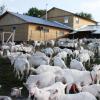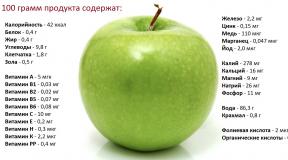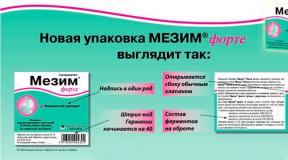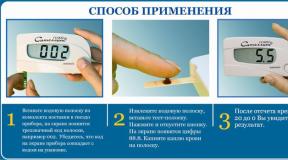Visanne - instructions for use, composition, indications, side effects, analogues of the active substance. Visanne: instructions for using Visanne tablets if you missed one pill
Bysanne- it hormonal drug, which has a complex effect. The action of the drug is due to its active substance.
Dienogest is a nortestosterone derivative that has no androgenic activity, but has a significant antiandrogenic effect, which is approximately one third of the activity of cyproterone acetate.
Dienogest binds to progesterone receptors in the human uterus with only 10% of the relative affinity for progesterone. Despite the low affinity for progesterone receptors, dienogest is characterized by a powerful progestogenic effect in vivo.
Dienogest does not have significant androgenic, mineralocorticoid or glucocorticoid activity in vivo.
Dienogest acts on endometriosis by reducing endogenous production of estradiol and thereby suppressing its trophic effects on both eutopic and ectopic endometrium. With continuous use, dienogest creates a hypoestrogenic, hypergestagenic endocrine environment, causing initial decidualization of endometrial tissue, followed by atrophy of endometriotic lesions.
Additional properties of dienogest, such as immunological and anti-angiogenic effects, apparently contribute to its inhibitory effect on cell proliferation.
Performance data
In a 3-month study involving 102 patients taking Visanne, Visanne was shown to be superior to placebo in reducing endometriosis-related pelvic pain and clinically significant reductions in pain from baseline.
During the additional open-label phase of this placebo-controlled study, a further reduction in pelvic pain was observed during treatment for up to 15 months.
In addition, the efficacy of Visanne for endometriosis-related pelvic pain was shown in a 6-month comparative study of Visanne and the gonadotropin-releasing hormone (aGTRH) analog leuprorelin acetate (LA) in 120 patients treated with Visanne. Pain syndrome measured using a visual analogue scale (0-100 mm). In both groups, there was a clinically significant decrease in pain compared with baseline. At the same time, Visanne was shown to be no less effective than LA, based on a predetermined limit of no less efficiency, which was 15 mm (p<0,0001). В трех исследованиях с участием в целом 252 пациенток, получавших диеногест в дозе 2 мг в сутки, после 6 месяцев лечения было показано существенное уменьшение эндометриоидных очагов.
The contraceptive effect of Visanne has not been studied in larger studies.
Safety Data
During Visanna's treatment, endogenous estrogen levels are only moderately suppressed.
Bone mineral density was assessed in 21 patients before treatment and after 6 months of treatment, and there was no decrease in the average bone mineral density.
While taking Visanne for 15 months (n=168), there was no significant effect on standard laboratory parameters, including hematological and biochemical blood parameters, liver enzymes, lipids and HbA1C (glycosylated hemoglobin)
Indications for use:
A drug Bysanne used to treat endometriosis.
Mode of application:
For oral administration. Taking pills Bysanne can be started on any day of the menstrual cycle. Take one tablet per day without interruption, preferably at the same time every day, with liquid if necessary. Tablets must be taken continuously regardless of vaginal bleeding. After completing one package, start taking the next one without interruption in taking the tablets. Visanne's effectiveness may be reduced if tablets are missed, vomiting and / or diarrhea (if this occurs within 3-4 hours after taking the tablet). If one or more tablets are missed, the woman should take only one tablet as soon as she remembers, and then continue taking the tablets at the usual time the next day. A tablet not absorbed due to vomiting or diarrhea should be replaced with an additional dose of one tablet. There is no appropriate indication for the use of Visanne in elderly patients. There are no data indicating the need for dose adjustment in patients with renal insufficiency.
Side effects:
Side effects are more likely to occur in the first months of taking byzanne and their frequency decreases during treatment with the drug.
The following side effects have been observed in women while taking Visanne.
The most common side effects during treatment with Visanne, which were at least considered as possibly related to taking the drug, were: headache (9.0%), discomfort in the mammary glands (5.4%), decreased mood ( 5.1%) and acne (5.1%).
The following are adverse drug reactions categorized by organ system class according to MedDRA - Medical Dictionary for Regulatory Activity.
Side effects in each frequency group are presented in descending order of frequency. Frequency rates are based on pooled data from four clinical studies involving 332 patients (100%).
Often (≥1/100 and<1/10): прибавка массы тела, снижение настроения, изменения настроения, нарушения сна, нервозность, потеря либидо, головная боль, мигрень, тошнота, боли в животе, флатуленция, вздутие живота, рвота, акне, алопеция, боли в спине, дискомфорт в молочных железах, киста яичника, приливы жара, маточные*/вагинальные кровотечения, в том числе мажущие выделения, астенические состояния, раздражительность
Uncommon (≥1/1000 to<1/100): анемия, снижение массы тела, повышенный аппетит, беспокойство, депрессивное состояние, колебания настроения, дисбаланс периферической нервной системы, нарушение внимания, сухость глаз, звон в ушах, неспецифические нарушения кровообращения, сердцебиение, артериальная гипотензия, одышка, гингивит, дискомфорт в области живота, диарея, запор, воспалительные заболевания желудочно-кишечного тракта, сухость кожных покровов, гипергидроз, зуд, гирсутизм, онихоклазия, перхоть, дерматит, нарушение роста волос, реакции фоточувствительности, нарушение пигментации, боли в костях, мышечные судороги, боли в конечностях, ощущение тяжести в конечностях, инфекции мочевыводящих путей, вагинальный кандидоз, сухость в вульвовагинальной области, выделения из половых путей, боли в тазовой области, атрофический вульвовагинит, участки уплотнения в молочной железе, фиброзно-кистозная мастопатия, общее уплотнение молочных желез, отеки.
Contraindications:
bysanne should not be taken in several cases that are contraindications. In particular, you should not use the drug for: vascular diseases: thrombophlebitis and varicose veins; vascular atherosclerosis; allergic reactions; dysfunctions of the liver and kidneys; pregnancy and lactation. In case of non-compliance with the requirements of the doctor, as well as with the wrong dosage, side effects may occur. Sometimes they are diagnosed with normal admission, but in the future they usually pass quickly (within about two months).
Pregnancy:
Data on the use of the drug Bysanne in pregnant women are limited. Data obtained from animal studies and data on the use of dienogest in women during pregnancy did not reveal a specific risk for pregnancy, fetal development, childbirth and child development after birth. The drug Visanne should not be prescribed to pregnant women due to the lack of need for treatment of endometriosis during pregnancy.
Interaction with other drugs:
Gestagens, incl. dienogest, are metabolized mainly with the participation of CYP3A4, located both in the intestinal mucosa and in the liver. Therefore, inducers or inhibitors of CYP3A4 may interfere with the metabolism of progestin drugs.
Increased clearance of sex hormones due to enzyme induction can lead to a decrease in the therapeutic effect of the drug Visanne, as well as cause side effects, for example, a change in the nature of uterine bleeding.
Decreased clearance of sex hormones due to enzyme inhibition may increase dienogest exposure and cause side effects.
Substances capable of inducing enzymes
Interactions with drugs that induce microsomal enzymes (eg, cytochrome P450 systems) may occur, resulting in increased clearance of sex hormones (such drugs include phenytoin, barbiturates, primidone, carbamazepine, rifampicin, and possibly also oxcarbazepine, topiramate, felbamate , nevirapine, griseofulvin, and preparations containing St. John's wort).
The maximum induction of enzymes, as a rule, is noted not earlier than after 2-3 weeks, but then it can persist for at least 4 weeks after cessation of therapy.
The effect of the CYP3A4 inducer rifampicin has been studied in healthy postmenopausal women. With the simultaneous administration of rifampicin with estradiol valerate / dienogest tablets, a significant decrease in the equilibrium concentration and systemic exposure of dienogest was noted. Systemic exposure of dienogest at steady state, as measured by AUC (0-24 hours), was reduced by 83%.
Substances capable of inhibiting enzymes
Known CYP3A4 inhibitors such as azole antifungals (eg ketoconazole, itraconazole, fluconazole), cimetidine, verapamil, macrolides (eg erythromycin, clarithromycin and roxithromycin), diltiazem, protease inhibitors (eg ritonavir, saquinavir, indinavir, nelfinavir), antidepressants (eg, nefazodone, fluvoxamine, fluoxetine) and grapefruit juice may increase plasma concentrations of progestogens and cause side effects.
In one study, during which the effect of inhibitors of CYP3A4 (ketoconazole, erythromycin) was studied, the concentrations of estradiol valerate and dienogest in blood plasma at equilibrium concentrations were increased. In the case of simultaneous administration with a powerful inhibitor ketoconazole, the AUC value (0-24 h) at the equilibrium concentration of dienogest increased by 186%. With simultaneous use with a moderate inhibitor of CYP3A4 erythromycin, the AUC value (0-24 h) in dienogest at an equilibrium concentration increased by 62%. The clinical significance of these interactions has not been elucidated.
The effect of dienogest on other medicinal substances
Based on data from in vitro inhibition studies, a clinically significant interaction of Visanne with cytochrome P450 enzyme-mediated metabolism of other drugs is unlikely.
Note: To identify possible interactions, you should read the instructions for concomitant medicinal products.
Other types of interaction
The intake of progestogens may affect the results of some laboratory tests, including biochemical parameters of liver, thyroid, adrenal and kidney function, plasma concentrations of proteins (carriers), for example, lipid / lipoprotein fractions, parameters of carbohydrate metabolism and coagulation parameters.
Overdose:
About serious violations in case of overdose of the drug Bysanne not reported. Symptoms that may occur in overdose include nausea, vomiting, spotting or metrorrhagia. There is no specific antidote, symptomatic treatment should be carried out.
Storage conditions:
At a temperature not higher than 30 °C.
Keep out of the reach of children.
Release form:
Tablets.
14 tab. in a PVC/PVDC blister and aluminum foil. 2, 6 or 12 blisters are placed in a cardboard box.
Compound:
1 tablet Visanne contains: dienogest 2 mg.
Excipients: lactose monohydrate, potato starch, microcrystalline cellulose, povidone K25, talc, crospovidone, magnesium stearate.
Visanne is a drug that is widely used in obstetric and / or gynecological practice. The basis of the therapeutic effect of the drug is a derivative of the steroid hormone - dienogest. Visanne has pronounced gestagenic properties that inhibit the action of female sex hormones, estrogens. At the same time, the drug has a weak (compared to other drugs in this group) mineralocorticoid and glucocorticoid actions (the drug does not retain fluid in the body and provokes a sharp rise in blood pressure). Visanne is used to treat endometriosis in women, it is not used in men and children.
Composition and description of Bysanne
The composition of Visanne includes an active component - dienogest in microcrystallized form, and inactive components (starch, cellulose, povidone, magnesium stearate, etc.).
The active substance (dienogest) in a woman's body suppresses the action of female sex hormones, which stimulate the hormone-dependent growth of foci of endometriosis (a specific disease characterized by the degeneration of the endometrium - the uterine mucosa). With prolonged use of the drug, it binds to specific receptors in the uterus, which also slows down the growth of endometriosis foci. Ultimately, there is a depletion of the foci of the disease with their subsequent reverse development.
Indications for the use of Visanne
The main indication for the use of Visanne is endometriosis. For the treatment or prevention of other diseases, the drug is not prescribed.
Contraindications, side effects, overdose of Visanne
The method of using Visanne and the dosage of the drug during the second course of treatment are prescribed only by a doctor!
Like most drugs that contain a progestogen hormone, Visanne is not used for:
- Vascular diseases (thrombophlebitis, phlebothrombosis, etc.);
- atherosclerotic lesions of the vessels of the body;
- allergies to the components of the drug;
- diabetes mellitus complicated by vascular lesions;
- diseases of the liver and kidneys with severe violations of their functions;
- oncological diseases;
- pregnancy, lactation;
- childhood.
Side effects of Visanne most often develop during the first month of use and may disappear with continued use. The most common include weakness, headaches, decreased libido, weight gain, abdominal pain, nausea, vomiting, spotting bleeding from the genitals, and mood disorders.
More rare side effects: dizziness, anemia, inflammatory diseases of the gastrointestinal tract, inflammatory lesions of the genitourinary tract of a woman, depression, weight loss, etc.
An overdose of the drug is characterized by a sharp increase in the above symptoms with damage to the liver and kidneys, the development of blood clots of various localization (observed with uncontrolled and prolonged use).
Instructions for use of Visanne
The medicine is started on any day of the menstrual cycle and continued for six months. The medicine is prescribed regardless of the meal, you can drink a small amount of liquid. If a woman misses taking the drug, you should immediately take a pill, and take the next one at the appointed time.
Special instructions, analogues of the drug, release form
There is no addiction to the drug.
Reception of alcohol and Visanne is unacceptable.
Special instructions: the drug is prescribed with caution in heart failure, diabetes mellitus (without vascular damage), high blood pressure, a history of vein damage.
Visanne should also be taken with caution while prescribing drugs that affect the metabolic system of the liver (cytochrome-dependent drugs), for example, barbiturates, antidepressants, etc.
Visanne can distort some biochemical blood parameters (glucose, lipids, liver enzymes, pancreas, thyroid and kidney function).
Release form - tablets of 2 mg, in a package from 28 to 84 and 168 in a package.
Shelf life - 3 years.
Analogues of Byzanne: Astrell.
Manufacturer: Bayer Schering Pharma AG.
It is released from the pharmacy by prescription.
An extremely unpleasant situation for a woman with any variant of endometrioid disease is the inability to bear children. Visanne with endometriosis helps to reduce the severity of symptoms and create conditions for the successful conception of a baby. The drug has many advantages that are used to treat pathology, but there are disadvantages and side effects associated with long-term medication. Therefore, the hormonal agent is used as prescribed by the doctor and under mandatory medical supervision. The instructions for use indicate the main indication for therapy - endometriosis, and the doctors' reviews convincingly show that with the help of the drug you can remove the pain and find the happiness of motherhood.
The composition and properties of the drug
The basis of the drug is Dienogest at a dose of 2 mg. This biologically active substance with progesterone action has the following positive effects:
- restoration of hormonal balance with a decrease in estrogenic effects on the reproductive organs;
- inhibition of excessive thickening of the endometrium;
- a decrease in the number of nerve endings in endometrioid foci, which provides pain relief;
- suppression of the growth and spread of new arterial vessels that feed the foci of endometriosis;
- the death of cellular structures of the endometrium located in an atypical place;
- impact on the inflammatory process that is present against the background of the disease;
- suppression of the production of prostaglandins (substances that create conditions for pain).
The drug has a minimal effect on ovulation, which creates conditions for the possibility of pregnancy. Reviews of doctors show that the likelihood of a desired conception in women with endometriosis after the end of the Visanne intake is significantly higher.
Indications
Instructions for use indicate the main indication for the use of Visanne - endometrioid disease. Main goals for therapy:
- reduction of pain associated with menstruation;
- removal of pain in the intermenstrual period;
- impact on the severity of uterine bleeding during menstruation;
- creating conditions for the desired conception.
Dienogest works great as part of complex therapy, but Visanne can be used to treat endometriosis without the use of other drugs. It is important to follow the recommendations exactly, using the therapy regimen prescribed by the doctor.
Treatment involves continuous administration of the drug, 1 tablet per day for at least 6 months. It is very important to maintain a six-month regimen of therapy in order to obtain a positive effect.
Instructions for use allow you to start taking the medicine from any day of the cycle, but it is advisable to start treatment from the 1st day of menstruation, and then you can drink tablets on a regular basis, and you do not need to pay attention to spotting on the days of the expected menstruation.
The doctor may recommend the drug immediately after the detection of endometriosis with 1 or 2 degrees of spread of the disease. A good option is a course of therapy after surgery to remove an endometrioid tumor of the ovary or uterus. In each case, the choice is individual: the variety of types of endometriosis makes the doctor creative in the treatment of the disease.
Contraindications
Visanne is a hormonal drug that can have an adverse effect on the female body. You can not use long courses of therapy against the background of the following conditions and diseases:
- varicose disease with a high risk of complications (venous thrombosis, thrombophlebitis);
- any variants of liver diseases (hepatitis, cholelithiasis, jaundice, cirrhosis, tumors);
- any type of arterial blockage or heart failure (heart attack, stroke, angina pectoris, heart defects);
- diabetes;
- arterial hypertension on the background of obesity;
- gynecological diseases with a risk of oncopathology;
- neurological problems associated with headaches.
The doctors' comments clearly indicate the need for a preliminary examination: you cannot make a decision on your own and start drinking pills without finding out the presence of dangerous diseases or conditions.
Side effects
Problems arising from the use of Visanne most often occur in the first months of treatment. Not always, but possible:
- scanty intermenstrual vaginal bleeding;
- headache;
- swelling and pain in the mammary glands;
- the appearance of acne on the face;
- depressed mood.
The following problems are much less common:
- increase in body weight;
- psycho-emotional disorders (anxiety, impaired attention and memory, neurotic reactions, decreased sexual desire);
- troubles from the gastrointestinal tract (vomiting, nausea, diarrhea, constipation);
- muscle pain in the legs;
- exacerbation of candidal colpitis (thrush);
- swelling of the face and limbs.
Types of cancer
Visanne for endometriosis: reviews and method of using the drug
Today, many women are interested in reviews of "Byzanne" for endometriosis, tk. this is one of the most used drugs in the complex therapy of pathology, which is one of the most common. Almost all patients know that this disease is hormone-dependent, therefore, treatment should be aimed at correcting the hormonal background, and this causes serious concern for women. Most often, it is for this reason that many of them do not start the course on time. Meanwhile, do not forget that any pathological process entails its consequences and complications, therefore, instead of putting off the medicine and doubting, you need to figure out what it is, how it works and how it can help you.
Briefly about what is endometriosis
To begin with, you should take a little time to understand what endometriosis is. This is a fairly common disease in women of childbearing age, most often from 26 to 40 years.
Pathology is manifested by the growth of the endometrium where, by nature, it should not be. This layer is the mucous membrane of the uterus, which should only line the inside of the organ cavity, without leaving its limits. The structure of the mucosa is very complex, and it reacts quite clearly to all hormonal changes affecting the organs of the reproductive system. The first half of the menstrual cycle, the endometrium, along with the active production of estrogen, thickens, because. the uterus prepares to receive a fertilized egg, for which it creates the appropriate environment. If pregnancy has not occurred, then particles of overgrown tissue are removed from the body during menstruation.
Endometriosis is a fairly common disease in women of childbearing age.
It happens that fragments of the endometrium that have left the uterus are fixed on other tissues, for example, on the neck of the organ, ovary, fallopian tube, and sometimes outside the reproductive system (in the abdominal cavity, on the kidneys). Cells continue to divide, and at the same time, they do not lose their hormonal dependence, i.e. increase under the action of estradiol and are destroyed with increased synthesis of progesterone, separated during menstruation and bleed. Their further growth leads to the formation of adhesions that interfere with reproductive function.
Having dealt with the mechanism of the development of the disease, there is no doubt that treatment is impossible without normalizing the hormonal level, and it was for these purposes that the drug "Visanna" was developed.
The main bioactive component of the drug

Dienogest - a bioactive component of the drug "Visanna"
The main bioactive component of the drug called "Visanna" was micronized dienogest. It is a unique derivative of 19-nortestosterone, and of all other drugs of this class, it has the highest antiandrogenic activity, while not adversely affecting lipid metabolism. This component (progestin) acts directly on progesterone receptors, has neither glucocorticoid activity nor mineralocorticoid action.
Dienogest first of all begins to moderately block the secretion of gonadotropins, then it inhibits the process of endogenous production of estrogen and nutrition of the ectopic endometrium with this hormone. Thus, it is possible to suppress the growth of blood vessels in the foci of the mucosa that has grown outside the uterus, feeding the cells and ensuring their vital activity. At the same time, the active substance is characterized by an anovulatory effect, therefore, when taking the drug "Visanna" with endometriosis, pregnancy does not occur. The menstrual cycle and the ovulatory process are restored two months after the termination of the course of treatment.
Carefully! This drug has not been studied separately for contraceptive properties, so it is recommended not to ignore other contraceptive protection (such as a condom).
Dosage form and components that make up the drug

Received fairly good reviews in the treatment of endometriosis, the drug "Visanna" is available in the form of round white tablets with a flat surface and is packaged in blisters. In one tablet, in addition to the dienogest noted above, are introduced:
- lactose monohydrate;
- cellulose microcrystalline;
- potato starch;
- povidone K and crospovidone;
- magnesium stearate (a chemical compound obtained after combining Mg with stearic acid);
- talc.
In what cases is "Visanna" prescribed to patients?
The drug has only one indication for use - it is designed specifically for the treatment of endometriosis and helps to save a woman from the main signs of the disease:
- the appearance of pelvic pains of a cyclic nature, which, when the pathological process is running, can be almost permanent. Pelvic pain can not only be felt in the lower abdomen, but can be given to the lumbar region or thigh;
- an increase in the duration of menstrual bleeding (abundant discharge, can last longer than a week), which is also painful (pain appears before menstruation, can be very intense, and subside after the start of the cycle);
- manifestation of dyspareunia (soreness that occurs during sexual contact);
- the occurrence of problems with conception (with this pathology, many women develop infertility);
- the appearance of pain during urination or defecation (this can occur if the pathological process spreads outside the organs of the reproductive system).
Advantages and disadvantages noted from taking this medication
After analyzing the reviews of patients about the drug "Visanna" for endometriosis, we can derive a number of its obvious advantages and some disadvantages. Among the advantages noted:
- the ability to effectively eliminate the symptoms of the disease associated with pain (premenstrual, pelvic, sexual intercourse);
- fairly good tolerability of the drug;
- maintaining the analgesic effect for a sufficiently long period of time;
- a slight tendency to provoke menopausal symptoms (eg, hot flashes), which are usually caused by anovulatory drugs.

Increasing headache attacks is a rare side effect when taking the drug.
Among the positive reviews of doctors about "Vyzanne" for endometriosis, the above pluses include the ability of the drug to significantly and significantly reduce the volume of endometriosis foci, the absence of a negative effect on lipid levels and androgenic activity (in other words, filling the female body with male sex hormones).
Among the shortcomings that women often describe on the forums are the following:
- the appearance of intermenstrual bleeding. They are irregular, over time (in the process of further treatment) their intensity decreases;
- increased frequency of headache attacks;
- an increase in body weight (this sign is observed infrequently, and here we are not talking about the development of obesity, there may simply be a slight weight gain in the range of 2-3 kg).
Features of the appointment of the drug "Visanna" and contraindications for admission

In diabetes mellitus, the use of "Visanne" is contraindicated
The appointment of the drug is carried out only on the basis of a complete diagnosis, which confirms the diagnosis of the development of endometriosis and identifies other pathologies that are incomparable with the use of this hormonal agent. Instructions for use for endometriosis "Visanna" does not recommend its appointment with:
- acute thrombophlebitis;
- breast cancer;
- diabetes mellitus, accompanied by complications in relation to blood vessels;
- severe liver disease;
- uterine bleeding of unknown origin;
- atherosclerosis;
- the development of tumor diseases (both malignant and benign in nature, if the process is progressing at the present time).
Do not prescribe these pills to girls under the age of 18. With great care, a treatment program with this remedy is selected for women who have previously had a stroke, myocardial infarction, as well as for patients with heart failure.
Given the described list of contraindications, the drug is prescribed strictly after a complete diagnosis, including a gynecological examination with a bimanual vaginal examination, smear cytology, laboratory smear and blood analysis, and ultrasound of the pelvic organs. If certain suspicions arise, the doctor may order a mammogram.
How treatment is carried out using the drug, the regimen and some features
Some time ago, doctors adhered to the principle that the development of this pathological process requires the removal of the uterus. Today, the view on the treatment of the disease has changed dramatically and has become based on gentle, organ-preserving methods that allow women to fully return to normal life after therapy and experience the joy of motherhood. To eliminate endometriosis, you can choose:
- conservative method of treatment (based on medication);
- surgical intervention;
- combination therapy (combination of the two above methods).

Conservative method of treatment - an effective method of treatment
Good reviews about "Visanna" with endometriosis can be found both with a separate appointment and in a combined treatment program. The most effective result can be achieved if a course of hormone therapy is carried out, thus stopping the development of the process (the main active ingredient inhibits the production of estrogen by the ovaries, leading to the growth of the endometrium), and then, with the help of surgery, remove endometriosis foci. Also, the appointment of this remedy after laparoscopy serves to prevent the recurrence of pathology.
Conservative treatment with this medicine is designed for six months. Judging by the reviews about the instructions for using "Visanne" for endometriosis, it is the duration of therapy that leaves many patients with not the most pleasant impressions, but at the same time, this is a real opportunity to preserve the organ and the reproductive function of the body. The application scheme strictly prescribes:
- taking 1 tablet per day (always with water);
- duration - six months, without breaks;
- daily use at the same time.
The scheme of drug use is not affected by the time of eating, the beginning of the menstrual cycle, and other features that often correct treatment with other drugs. If suddenly, after the woman took the drug, vomiting began, and the pill was not absorbed, then it is necessary to drink another one on the same day.
Attention! "Visanna" is not compatible with alcohol, therefore, throughout the treatment, you should stop drinking alcohol.
What are the side effects of hormone therapy?
Many reviews of "Visanne" for endometriosis contain a description of the side effects that may accompany the course of therapy. There are few of them, because in most cases, the drug is well tolerated, without adverse effects. Most often, side effects appear at the beginning of treatment, and there are cases of a rather intense manifestation of some of them, but with further admission, the patient's condition stabilizes and gradually unpleasant side effects disappear. These manifestations include:

"Visanna" and other modern drugs used in the treatment of endometriosis: review, comparison
Today, various drugs have been developed for the treatment of endometriosis, and only a doctor can determine which is better in your case. when prescribing, a number of nuances, features of the development of pathology and some chronic diseases occurring in the patient's body are taken into account.
"Visanna" acts quite effectively, it most often does not cause side effects, and if they appear, they quickly disappear. The drug works exclusively to eliminate endometriosis foci and stop the pathological process, does not show androgenic activity, is based on a bioactive component of natural origin. One of the advantages of the drug in the reviews of the drug "Visanna" for endometriosis is the price, because. despite the need for a long course of treatment, it remains available to all patients.

"Dufaston" - a popular remedy for endometriosis
Another popular remedy was "Dufaston", which has a wider spectrum of action. It reduces the contraction of the myometrium, helps to improve the blood supply to the organs of the reproductive system, helps to reduce the production of estrogen. Meanwhile, many patients, taking it, complain of the appearance of severe headaches, an allergic reaction to the main component, and increased swelling of the extremities. Then a replacement is selected for the drug.
In the treatment of endometriosis, Janine is often prescribed, known to many as a contraceptive, the mechanism of action of which is the suppression of ovulation. It is also like "Visanne" based on dienogest, has a completely similar effect, helps to eliminate the growth of pathological endometriosis foci. It is not prescribed for patients who develop varicose veins.
Quite a lot of positive feedback was received by Qlaira, which is also based on dienogest. Along with it, the composition is based on estradiol valerate - a natural component that has a minimal effect on the liver (due to which it is not prohibited in many of its diseases), does not adversely affect blood clotting. At the same time, an analogue of estrogen is present in the composition, which can lead to provoking the further development of endometriosis, therefore this medicine is prescribed very carefully, according to a scheme that only a doctor will select and strictly individually. To the side effects described above, which in principle are observed in all drugs of this group, when taking Qlaira, a decrease in sexual desire may be added.
Having examined in detail the actions and properties of such a drug as "Visanne", as well as a variety of other popular means for conservative treatment, one conclusion can be drawn: only a doctor can correctly prescribe a course of hormone therapy and strictly individually. Treatment should give a positive effect on the disease, but without causing harm to the patient's body.
Price in the online pharmacy site: from 3 256
Description
Visanne is a hormone-containing drug that has a complex effect on the body. The active ingredient dienogest inhibits the action of sex hormones that contribute to the pathological growth of the endometrium.
Composition and form of release

The drug Visanne is available in the form of flat, rounded tablets with oblique edges. The letter "B" is engraved on one side.
Active ingredient: micronized dienogest - 2 mg.
Inactive components: lactose monohydrate - 62.8 mg, potato starch - 36 mg, povidone K25 - 8.1 mg, microcrystalline cellulose - 18 mg, talc - 4.05 mg, crospovidone - 2.7 mg, magnesium salt of stearic acid 1 .35 mg.
Pharmacodynamics
The active ingredient dienogest is a nortestosterone derivative that exhibits an antiandrogenic function that combines a third of the action of cyproterone acetate. By joining the progesterone nerve endings in the uterus, dienogest shows only 10% affinity for progesterone. Although its affinity is too low, it has a powerful progestogenic effect, which is confirmed by clinical trials on living organisms. Dienogest does not show significant mineralocorticoid or glucocorticoid function.

The active ingredient affects endometriosis by suppressing the trophic effect of estrogen on the eutopic and ectopic endometrium, reduces the synthesis of estrogen by the ovaries and significantly reduces their accumulation in the plasma.
Long-term use of Visanne promotes decidualization of endometrial tissue with further inhibition of endometriosis sites.
Showing auxiliary immunological and anti-angiogenic action, dienogest inhibits cell proliferation.
There was no decrease in bone mineral density and no significant effect of Visanne on the results of diagnostic tests of blood, liver enzymes, fats and glycated hemoglobin.
The active ingredient of the drug moderately reduces the production of estrogen by the ovaries.
Pharmacokinetics
Absorption
Ingested dienogest is instantly and almost all absorbed. The maximum amount of the substance in the blood serum of 47 ng / ml is determined after 1.5 hours. The amount of the active component reaching the place of its impact is 91%.
Distribution
Dienogest binds to serum albumin and does not bind to steroid hormone-binding globulin or corticosteroid-binding globulin. Up to 90% of the substance is attached to albumin, and 10% remains in the blood plasma as a free steroid. The estimated volume of liquid in which dienogest is distributed reaches 40 liters.
Metabolism
Dienogest is processed almost without residue by hydroxylation with the final generation of inert substances. According to tests outside living organisms and experiments on living beings, the main enzyme involved in the metabolism of the active ingredient of the pharmaceutical product, and this is cytochrome P450 3A4, has been isolated. The remains of the substances are excreted instantly, so the unchanged form of dienogest prevails in the plasma.
The rate of complete purification of the blood serum from the substance is 64 ml/minute.
Withdrawal of the pharmaceutical
The decrease in the amount of dienogest in the blood serum occurs in two phases. The period during which the amount of the active ingredient in the body is halved is 9-10 hours. Visanne at a dose of 0.1 mg/kg, taken orally, is excreted in the feces and urine as metabolites in a ratio of 3:1. The time of excretion of half of the metabolites of dienogest by the kidneys from the body reaches 14 hours. Approximately 86% of the active ingredient taken orally is excreted in 6 days, and the base share is excreted by the kidneys on the first day.
Equilibrium concentration
The mechanism of the relationship between the processes taking place in the body with dienogest remains regardless of the amount of globulin that binds steroid hormones. The amount of the active ingredient of the drug in the blood serum increases by 1.24 times with everyday use. Equilibrium concentration is achieved after 4 days of therapy. The effect of dienogest from several doses taken is predicted by the effect of a single dose taken orally.
Indications
Therapy for endometriosis.
Contraindications
Visanne is not recommended to be prescribed if there are manifestations that are common for progestogen-containing medications. With the development of the following symptoms that appear during the reception of the drug, its use should be immediately discontinued:

The drug Visanne is used with forethought when there is depression, ectopic pregnancy, high blood pressure, chronic heart failure, migraine headaches, increased blood lipids, blockage of deep-seated veins in the history of diseases.
Pregnancy and breastfeeding
There is little information on the use of the drug for women who are carrying a child. According to experiments conducted on living beings, dienogest does not pose a significant danger to pregnant women, the life of the fetus and the child after birth. Visanne is not prescribed for pregnant women due to the uselessness of endometriosis therapy at this time.
The period of breastfeeding the baby
The pharmaceutical product is not recommended during lactation, because, according to studies, the presence of dienogest in mother's milk has been determined. Whether to stop breastfeeding during therapy is determined by taking into account the benefits for the baby of breastfeeding and the benefits of therapy for the mother.
Terms of use, dosage
According to the instructions for use, Visanne is prescribed for six months. Whether to extend the treatment with a medication is decided by the attending physician based on the inherent complex of signs of the disease.
Order of appointment

Therapy is started on any day of the menstrual cycle.
Pharmsredstvo appoint 1 tablet without interruption daily at a certain time, drinking plenty of liquid. The medication is not stopped for the period of vaginal bleeding. Having finished taking the whole package, without interruption, start a new one.
With the appearance of vomiting, diarrhea or skipping a medicinal dose, the drug Visanne reduces its effectiveness. If one or more doses of the remedy are missed, it is recommended to take one tablet when the patient remembered about it, and then continue using it as usual. With vomiting and diarrhea, when the absorption of the drug has not occurred, it is necessary to drink an additional tablet.
Unwanted Effects
Adverse reactions often appear at the beginning of therapy, each subsequent month of treatment their presence is reduced. Those undesirable effects that often develop include: vaginal bleeding (spotting discharge, heavy bleeding from the uterus, irregular cycles), cephalalgia, pain in the mammary glands, acne.
Often (≥1/100 to
Adverse reactions that develop rarely (from ≥1 / 1000 to
Overdose
The dangerous consequences of exceeding the dose are not indicated. Manifestations of undesirable reactions may increase. Therapy is carried out symptomatically, since no antidote has been identified.
Special Instructions
The instructions indicate that before using the drug, you need to make sure there is no pregnancy. Visanne is recommended for women in conjunction with barrier methods of contraception.
Fertility
In most women, the drug inhibits the release of eggs, but it is not prescribed as a contraceptive.
The menstrual cycle is established in the interval of 2 months after the end of therapy with the drug. The expediency of using the medication for women where there is an ectopic pregnancy or disorders of the fallopian tubes in the history of the disease is determined by the doctor, taking into account all possible risks.
In the event of the occurrence or complication of the following manifestations, an assessment of the condition is carried out and only then it is decided whether to continue or start therapy.
Circulatory disorders
In the course of scientific experiments, there is not enough evidence of a connection between a progestogen pharmaceutical agent and the occurrence of myocardial infarction or blockage of cerebral vessels. The risk of heart and vascular pathologies, blood circulation disorders in the brain is associated with age-related changes and unhealthy habits. The risk of a stroke increases from taking a medication with high blood pressure.
Visanne is not prescribed for prolonged loss of mobility, after stabilization of the condition, the pharmaceutical agent is used after 14 days. Before the upcoming surgery, the medicine is stopped using for a month.
The risk of developing blood clots in the period after childbirth increases. If there is a fear of the occurrence of this pathology or blockage of the veins, the use of the remedy is immediately interrupted.
Neoplasms
Scientific studies have confirmed a relatively low risk of breast tumors in women who used oral contraceptives, mainly estrogen-progestin medications. This tendency decreases over 10 years after contraceptive withdrawal. The risk of cancer in women using contraceptives with a purely progestogen ingredient is tantamount to the risk associated with the use of combined contraceptives. But this information has not been proven.
Quite rarely, after therapy with hormonal substances similar to the Bysanne pharmaceutical, the appearance of benign and even more rarely malignant tumors in the liver was diagnosed.
Changing the nature of bleeding

In many women, the medicine changes the nature of the menstrual flow. For the period of therapy, uterine bleeding increases with a pathological change in the endometrium or a benign growth of muscle fibers in the uterus.
Long and heavy periods provoke anemia. In such cases, the drug is canceled.
Other signs
Women with depression should be treated with medication under supervision. In the case of the development of persistent hypertension during the period of drug treatment, dienogest is canceled, drugs that lower blood pressure are prescribed.
Pregnant women with the development of large foci of pigmentation of the integument should avoid excessive insolation and exposure to ultraviolet radiation.
During therapy with dienogest, persistent follicles in the ovaries may appear. More often this phenomenon is not noticeable, but sometimes there are pains in the pelvic region.
Lactose
One dose of the drug contains 63 mg of lactose monohydrate. Patients on a lactose-free diet should take into account the amount of the substance found in this medicine.
Children
The drug is not prescribed for children under 18 years of age.
Postmenopausal period
Women in the postmenopausal stage is not used.
Kidney function disorders
There is no information requiring dose adjustment in patients with impaired renal function.
Influence on the speed of reaction when driving vehicles or working with other mechanisms
Byzanne does not affect the human consciousness, its coordination and attentiveness when driving transport and other driving mechanisms. Women with impaired coordination should use the product with caution.
Release form
Available in blister packs of 24 tablets. 2, 6, 12 blisters in a cardboard packaging.
Storage
Keep the product at a temperature not exceeding 30 ° C, away from children.
Expiry date
Not more than 5 years. Do not use after expiration of the expiration date.



















